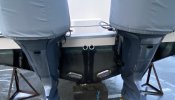- Joined
- Jun 30, 2008
- Messages
- 727
- Reaction score
- 80
- Points
- 28
- Location
- Ocean Pines, MD
- Model
- Express 330
My starboard underwater light (ugh) failed after 2(Ocean LED X16 Spectrum) and I may need to install new lights (looking at Lumitec SeaBlazeX2’s). If I do, I might move them higher up the stern on my ‘06 330. So my question is about sealing the existing and new holes. What I did before is to drill hole and seal with West System Six10 Thickened Epoxy Adhesive and once dry, drill smaller hole down center and use 4200 sealant. Is that the best product to use? I want to be sure to avoid any possible water intrusion since I know there is some wood in my transom.
Is there another product or technique I should use instead?
Will the epoxy be good enough to seal the hole up?
Thanks,
Is there another product or technique I should use instead?
Will the epoxy be good enough to seal the hole up?
Thanks,



